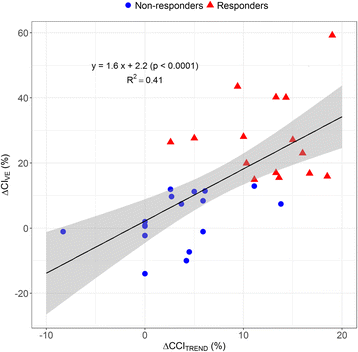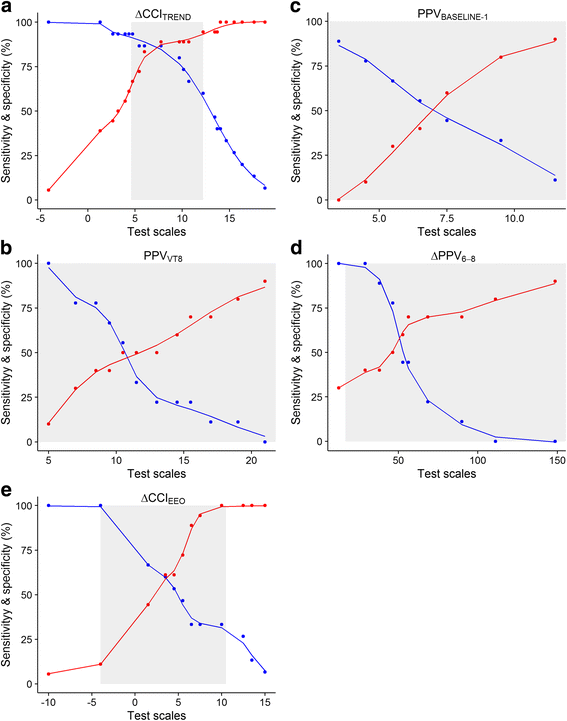Change in cardiac output during Trendelenburg maneuver is a reliable predictor of fluid responsiveness in patients with acute respiratory distress syndrome in the prone position under protective ventilation
- PMID: 29208025
- PMCID: PMC5718075
- DOI: 10.1186/s13054-017-1881-0
Change in cardiac output during Trendelenburg maneuver is a reliable predictor of fluid responsiveness in patients with acute respiratory distress syndrome in the prone position under protective ventilation
Abstract
Background: Predicting fluid responsiveness may help to avoid unnecessary fluid administration during acute respiratory distress syndrome (ARDS). The aim of this study was to evaluate the diagnostic performance of the following methods to predict fluid responsiveness in ARDS patients under protective ventilation in the prone position: cardiac index variation during a Trendelenburg maneuver, cardiac index variation during an end-expiratory occlusion test, and both pulse pressure variation and change in pulse pressure variation from baseline during a tidal volume challenge by increasing tidal volume (VT) to 8 ml.kg-1.
Methods: This study is a prospective single-center study, performed in a medical intensive care unit, on ARDS patients with acute circulatory failure in the prone position. Patients were studied at baseline, during a 1-min shift to the Trendelenburg position, during a 15-s end-expiratory occlusion, during a 1-min increase in VT to 8 ml.kg-1, and after fluid administration. Fluid responsiveness was deemed present if cardiac index assessed by transpulmonary thermodilution increased by at least 15% after fluid administration.
Results: There were 33 patients included, among whom 14 (42%) exhibited cardiac arrhythmia at baseline and 15 (45%) were deemed fluid-responsive. The area under the receiver operating characteristic (ROC) curve of the pulse contour-derived cardiac index change during the Trendelenburg maneuver and the end-expiratory occlusion test were 0.90 (95% CI, 0.80-1.00) and 0.65 (95% CI, 0.46-0.84), respectively. An increase in cardiac index ≥ 8% during the Trendelenburg maneuver enabled diagnosis of fluid responsiveness with sensitivity of 87% (95% CI, 67-100), and specificity of 89% (95% CI, 72-100). The area under the ROC curve of pulse pressure variation and change in pulse pressure variation during the tidal volume challenge were 0.52 (95% CI, 0.24-0.80) and 0.59 (95% CI, 0.31-0.88), respectively.
Conclusions: Change in cardiac index during a Trendelenburg maneuver is a reliable test to predict fluid responsiveness in ARDS patients in the prone position, while neither change in cardiac index during end-expiratory occlusion, nor pulse pressure variation during a VT challenge reached acceptable predictive performance to predict fluid responsiveness in this setting.
Trial registration: ClinicalTrials.gov, NCT01965574 . Registered on 16 October 2013. The trial was registered 6 days after inclusion of the first patient.
Keywords: Acute circulatory failure; Acute respiratory distress syndrome; Cardiac output; Fluid responsiveness; Prone position; Protective ventilation.
Conflict of interest statement
Ethics approval and consent to participate
The study protocol was approved by the local ethics committee (Comité de Protection des Personnes Sud-Est IV, ID-RCB-2013-A00526-39). Written consent from the patients’ closest relatives was required for inclusion, and eventually confirmed by the patient after ARDS resolution.
Consent for publication
Not applicable.
Competing interests
The authors declare that they have no competing interests.
Publisher’s Note
Springer Nature remains neutral with regard to jurisdictional claims in published maps and institutional affiliations.
Figures





Similar articles
-
Prediction of fluid responsiveness in acute respiratory distress syndrome patients ventilated with low tidal volume and high positive end-expiratory pressure.Crit Care Med. 2008 Oct;36(10):2810-6. doi: 10.1097/CCM.0b013e318186b74e. Crit Care Med. 2008. PMID: 18766099
-
Tidal volume challenge to predict preload responsiveness in patients with acute respiratory distress syndrome under prone position.Crit Care. 2022 Jul 18;26(1):219. doi: 10.1186/s13054-022-04087-w. Crit Care. 2022. PMID: 35850771 Free PMC article.
-
Pulse Pressure Variation Adjusted by Respiratory Changes in Pleural Pressure, Rather Than by Tidal Volume, Reliably Predicts Fluid Responsiveness in Patients With Acute Respiratory Distress Syndrome.Crit Care Med. 2016 Feb;44(2):342-51. doi: 10.1097/CCM.0000000000001371. Crit Care Med. 2016. PMID: 26457754
-
Functional hemodynamic tests: a systematic review and a metanalysis on the reliability of the end-expiratory occlusion test and of the mini-fluid challenge in predicting fluid responsiveness.Crit Care. 2019 Jul 29;23(1):264. doi: 10.1186/s13054-019-2545-z. Crit Care. 2019. PMID: 31358025 Free PMC article.
-
Assessment of fluid responsiveness using pulse pressure variation, stroke volume variation, plethysmographic variability index, central venous pressure, and inferior vena cava variation in patients undergoing mechanical ventilation: a systematic review and meta-analysis.Crit Care. 2024 Aug 31;28(1):289. doi: 10.1186/s13054-024-05078-9. Crit Care. 2024. PMID: 39217370 Free PMC article.
Cited by
-
Fluid balance neutralization secured by hemodynamic monitoring versus protocolized standard of care in critically ill patients requiring continuous renal replacement therapy: study protocol of the GO NEUTRAL randomized controlled trial.Trials. 2022 Sep 22;23(1):798. doi: 10.1186/s13063-022-06735-6. Trials. 2022. PMID: 36138465 Free PMC article.
-
Use of Pulse Pressure Variation as Predictor of Fluid Responsiveness in Patients Ventilated With Low Tidal Volume: A Systematic Review and Meta-Analysis.Clin Med Insights Circ Respir Pulm Med. 2020 Jan 24;14:1179548420901518. doi: 10.1177/1179548420901518. eCollection 2020. Clin Med Insights Circ Respir Pulm Med. 2020. PMID: 32047358 Free PMC article.
-
Predictive value of trendelenburg position and carotid ultrasound for fluid responsiveness in patients on VV-ECMO with acute respiratory distress syndrome in the prone position.Sci Rep. 2024 Dec 30;14(1):31808. doi: 10.1038/s41598-024-83038-7. Sci Rep. 2024. PMID: 39738306 Free PMC article.
-
The end-expiratory occlusion test for detecting preload responsiveness: a systematic review and meta-analysis.Ann Intensive Care. 2020 May 24;10(1):65. doi: 10.1186/s13613-020-00682-8. Ann Intensive Care. 2020. PMID: 32449104 Free PMC article.
-
The Japanese Clinical Practice Guidelines for Management of Sepsis and Septic Shock 2020 (J-SSCG 2020).Acute Med Surg. 2021 Aug 26;8(1):e659. doi: 10.1002/ams2.659. eCollection 2021 Jan-Dec. Acute Med Surg. 2021. PMID: 34484801 Free PMC article.
References
-
- Michard F, Boussat S, Chemla D, Anguel N, Mercat A, Lecarpentier Y, et al. Relation between respiratory changes in arterial pulse pressure and fluid responsiveness in septic patients with acute circulatory failure. Am J Respir Crit Care Med. 2000;162:134–8. doi: 10.1164/ajrccm.162.1.9903035. - DOI - PubMed
Publication types
MeSH terms
Associated data
LinkOut - more resources
Full Text Sources
Other Literature Sources
Medical

